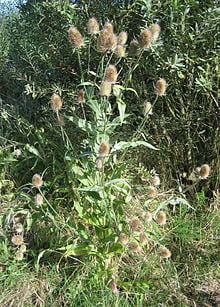Dipsacus

Dipsacus is a genus of flowering plant in the family Caprifoliaceae.[1] The members of this genus are known as teasel, teazel or teazle. The genus includes about 15 species of tall herbaceous biennial plants (rarely short-lived perennial plants) growing to 1–2.5 metres (3.3–8.2 ft) tall. Dipsacus species are native to Europe, Asia and northern Africa.
The genus name (dipsacus) is derived from the Greek word for thirst (dipsa) and refers to the cup-like formation made where sessile leaves merge at the stem.[2][3]
The name teasel derives from words such as Old English tǣsl, tǣsel; relating to the verb “to tease” – the dried heads of the plant were once used in the textile industry to raise the nap on woolen cloth.[4]
Teasels are easily identified with their prickly stem and leaves, and the inflorescence of purple, dark pink, lavender or white flowers that form a head on the end of the stem(s). The inflorescence is ovoid, 4–10 centimetres (1.6–3.9 in) long and 3–5 centimetres (1.2–2.0 in) broad, with a basal whorl of spiny bracts. The first flowers begin opening in a belt around the middle of the spherical or oval flowerhead, and then open sequentially toward the top and bottom, forming two narrow belts as the flowering progresses. The dried head persists afterwards, with the small (4–6 millimetres (0.16–0.24 in)) seeds maturing in mid autumn. In rainy weather, some seeds may germinate when still in the seedhead (vivipary).
